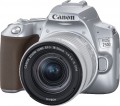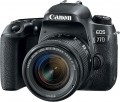DxOMark rating
The result shown by the camera in the DxOMark ranking.
DxOMark is one of the most popular and respected resources for expert camera testing. According to the test results, the camera receives a certain number of points; The more points, the higher the final score.
Light sensitivity (ISO)
The sensitivity range of a digital camera matrix. In digital photography, light sensitivity is expressed in the same ISO units as in film photography; however, unlike film, the light sensitivity of the sensor in a digital camera can be changed, which gives you more options for adjusting shooting parameters. High maximum light sensitivity is important if you have to use a lens with a low aperture (see Aperture), as well as when shooting dimly lit scenes and fast-moving objects; in the latter case, high ISO allows you to use low shutter speeds, which minimizes image blur. However, note that with an increase in the value of the applied ISO, the level of noise in the resulting images also increases.
HDR
Camera support for
HDR.
HDR stands for High Dynamic Range. The main application of this technology is shooting scenes with significant differences in illumination, when there are both very bright and very dark areas in the frame. The features of modern digital photography are such that in the normal shooting mode, only a rather narrow range of brightness can be correctly processed; as a result, with a large difference in illumination, the image contains either too dark or overexposed fragments. HDR avoids this phenomenon: in this mode, the camera takes several shots with different exposure settings, and then glues them together in such a way as to reduce the brightness in bright places and increase in dark places. This allows you to shoot, for example, landscapes against the backdrop of a bright sunset sky, the interiors of dimly lit buildings with bright windows, etc. In addition, HDR can also be used as an artistic technique — to give the picture an unusual colour scheme.
Note that this effect can also be achieved using post-processing in a graphics editor; however, using the camera is much more convenient.
Ultra HD (4K)
The maximum resolution and frame rate of video captured by the camera in
the Ultra HD (4K) standard.
UHD 4K refers to resolutions with a frame size of approximately 4,000 horizontal pixels. Specifically, in cameras for video shooting, resolutions of 3840x2160 and 4096x2160 are most often used. Regarding the frame rate, it is worth noting first of all that a normal (not slow-motion) video is shot at a speed of up to 60 fps, and in this case, the higher the frame rate, the smoother the video will be, the less jerks will be noticeable when moving in the frame. If the frame rate is 100 fps or higher, this usually means that the camera has a slow-motion video mode.
Video scene modes
The number and / or types of scene programs for shooting videos provided in the design of the camera.
Scene programs are a set of presets designed for different shooting situations - for example, in sunlight, on a cloudy day, in a darkened room, etc. Also, this list may include other specific modes - for example, creative tools. In any case, the presence of scene programs facilitates the choice of video shooting parameters, which is very useful for novice users.
Maximum video length
Restrictions on the length of the recorded video provided in the design of the camera. In some models, the recording time is limited in time (for example, 30 minutes) — thus, to record a longer video, it will have to be split into separate clips. In others, the duration depends only on the amount of free memory — you can record as long as there is enough space. There is also a combination of these options; in such models, video recording stops as soon as either of the two limits is reached.
Focus points
The number of focus points (autofocus) provided in the design of the camera.
The focus point is the point (more precisely, a small area) in the frame from which the autofocus system reads data for focusing. The simplest systems work with a single point, but their capabilities are very limited, and this option is practically not found today. Modern digital cameras have at least three focus sensors, and in the most advanced models this figure can reach several dozen.
The more autofocus sensors there are in the camera, the more advanced its autofocus capabilities will be, the more specific techniques it allows you to use. In this case, the selection of specific points used can be carried out both automatically, simultaneously with the choice of the subject program, and manually (however, the second option is more typical for professional cameras). In addition, the abundance of focus points has a positive effect on the quality of the tracking autofocus (see "Autofocus Modes").
In general, more focus sensors are generally considered a sign of a more advanced camera; however, differences in quality become really noticeable only if the difference in the number of points is significant - for example, if we compare models with 9 and 39 points. A lot also depends on the location of the points in the frame - it is believed that sensors distributed over a wide area work better than densely located in the center of the frame, even if their number is the same.
Viewfinder
The type of
viewfinder provided in the design of the camera.
A viewfinder is an eyepiece in which the photographer is able to see the image being shot, and in some cases additional information (the location of autofocus sensors, individual shooting parameters, etc.). Regardless of the type, viewfinders are useful in that they allow you to clearly see the image you are shooting, even in bright ambient light (which can cause displays to “blind”). Their disadvantages are the need to bring the camera close to the face, as well as the inconvenience when working with glasses (although the latter is partly offset by diopter correction in the viewfinder itself). The types of viewfinders can be as follows:
— Electronic. Such a viewfinder is a system of lenses with a small screen behind them. It is widely used in advanced cameras with non-replaceable lenses (see "Camera Type"), can be used in MILC cameras, and relatively recently full-fledged "
SLRs " have appeared (in particular, made according to the so-called "translucent mirror technology") equipped with electronic viewfinders. The advantage of such a viewfinder is that, in addition to the image itself, it can display a large amount of service information (for example, about shooting parameters); the main disadvantage is the need to supply power from the battery (although the power consumption of such a system is still much lower than that of an
...external display).
— Optical. In this case, an optical viewfinder means an independent system with its own eyepiece and lens, built into the camera body and directed parallel to the optical axis of the lens (mirror and prism systems are separated into separate categories). Such a system can be located both directly above the lens and in the corner of the body. The advantages of optical viewfinders are simplicity, low cost and compactness, due to the absence of a complex system of mirrors or prisms in the design. Such a viewfinder can be used in any non-reflex cameras (classic digital or MILC). The main disadvantage of this option is the mismatch between the position of its lens and the main lens of the camera (the so-called parallax effect); in most cases, this does not create inconvenience, but when shooting at close distances, you have to take an amendment (although there are camera models with viewfinders that automatically correct).
— Optical and electronic. A specific type of viewfinder that combines elements of both systems described above. Usually, such structures are based on an optical viewfinder, which provides for the possibility of projecting various service information onto a visible image. And in some models, the system can also be switched to a fully electronic mode, blocking the access of light through the optics and observing only the picture on the screen through the viewfinder.
— Optical (mirror). As the name implies, the design of such a viewfinder is based on a system of mirrors. Through this system, the real image perceived by the camera lens is fed into the viewfinder eyepiece (in other words, the photographer is actually looking directly through the lens). SLR viewfinders are used exclusively in cameras of the corresponding type (see above). Their advantages are the absence of the parallax effect and the ability to immediately evaluate a number of shooting parameters, such as depth of field, the effect of installed light filters, etc. The main disadvantage of reflex viewfinders is the need to raise the mirror at the time of shooting. This complicates and increases the cost of the design, makes it less reliable, and the operation of the mirror lifting mechanism can cause vibrations and the “stirring” effect.
— Optical (pentaprism). In fact, it is a kind of mirror viewfinder (see above), in which the role of a part of the mirrors is assigned to a pentaprism — a glass structure of a special shape. The action of the pentaprism is based on the effect of the so-called total internal reflection; it is believed that in this way it is possible to achieve a brighter and clearer image than when using classic mirrors. Other advantages and disadvantages are identical to conventional reflex viewfinders (see above). The pentaprism is widely used in mirror devices.
— Is absent. The complete absence of a viewfinder in the design of the camera; For sighting in such models, a display is used. This feature is typical mainly for digital compacts (see "Type of camera"). Firstly, the dimensions of the body of such models often do not allow for a viewfinder to be included in the design; secondly, the specifics of the use of such cameras is usually such that the display is quite enough for them, and sometimes it is even more preferable — for example, when shooting from a non-standard position (above your head, with your arm outstretched in front of you, etc.).Viewfinder crop
This setting can be simplistically described as the amount of magnification provided by the viewfinder relative to how the image appears to the naked eye. The features of modern viewfinders are such that most of them have crop values less than 1 — that is, it somewhat reduces the visible “picture”.
In general, the larger this parameter, the larger the objects look in the viewfinder and the easier it is to focus through it.

